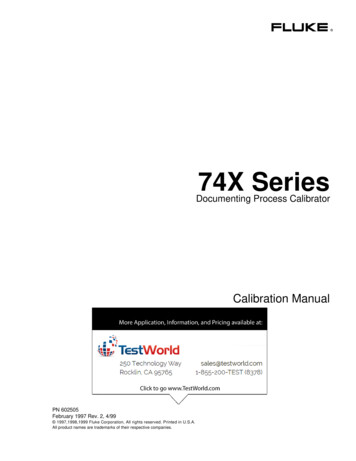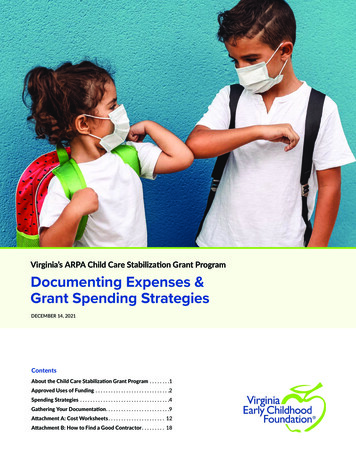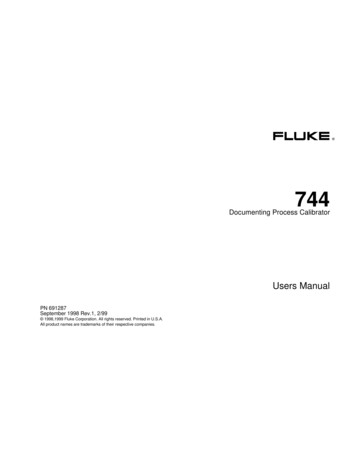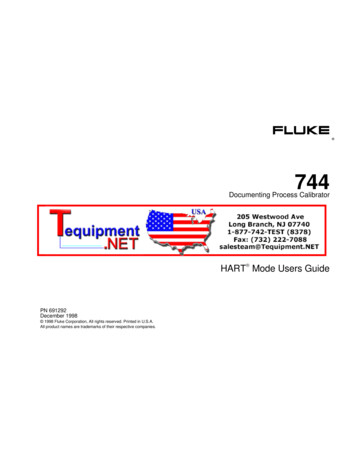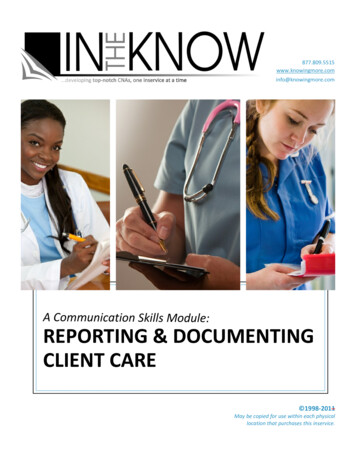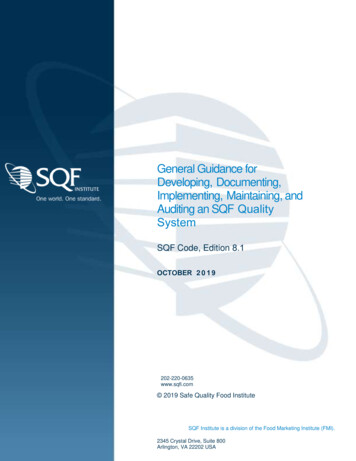
Transcription
General Guidance forDeveloping, Documenting,Implementing, Maintaining, andAuditing an SQF QualitySystemSQF Code, Edition 8.1OCTOBER 2 0 1 9202-220-0635www.sqfi.com 2019 Safe Quality Food InstituteSQF Institute is a division of the Food Marketing Institute (FMI).2345 Crystal Drive, Suite 800Arlington, VA 22202 USA
Guidance for Developing, Documenting, Implementing,Maintaining and Auditing the SQF Quality Code, Edition 8.1PrefaceThis document provides general guidance for SQF sites, consultants and auditors when implementingand auditing SQF Quality Code, Edition 8.1 and can be used where no specific industry sector guidanceis available.The purpose of SQF Code implementation is not only to achieve certification, but to assure constantand continual validation and review of a site’s SQF System for compliance and completeness.Effective implementation of the SQF Code requires the commitment of the site management and theconstant involvement and participation of site staff to maintain the safety and quality of SQF certifiedproducts. The results of effective SQF implementation are not only the protection of public health andcompany brands, but also improvement in margins by reduction of waste, recalls and withdrawals,and improved productivity through “doing it right the first time.”The SQF Institute is grateful to the SQF Institute’s Technical Advisory Council and SQF stakeholdersfor their assistance in reviewing and contributing to this document. 2019 Food Marketing InstituteSQF Quality Code System Elements Guidance Document1
Guidance for Developing, Documenting, Implementing,Maintaining and Auditing the SQF Quality Code, Edition 8.1Table of ContentsPreface. 1Section 1. Introduction . 31.1Purpose of the Guidance Documents . 31.2Layout of the SQF Code . 3Section 2. The SQF Certification Process . 4Section 3. The SQF Implementation Process . 4Section 4. Introduction to this Guide . 61. Purpose and Scope of this Guide . 62. The Structure of the SQF Code . 63. The Structure of an SQF System . 64. Format of the Guidance . 7Section 5. Module 2: SQF Systems Elements . 82.1Management Commitment . 82.2Document Control and Records . 162.3Specification and Product Development . 192.4Food Quality System . 252.5Food Quality System Verification . 342.6Product Identification, Trace, Withdrawal and Recall . 402.7Food Fraud . 432.8Identity Preserved Foods . 442.9Training . 46 2019 Food Marketing InstituteSQF Quality Code System Elements Guidance Document2
Guidance for Developing, Documenting, Implementing,Maintaining and Auditing the SQF Quality Code, Edition 8.1Section 1. Introduction1.1Purpose of the Guidance DocumentsThe purpose of this series of SQF Guidance Documents is to assist sites with designing, developing,documenting, implementing and maintaining an SQF System using the SQF Quality Code, Edition 8(SQF Code), and to assist SQF registered auditors in auditing against the code.The relevant Code version number is identified in the document header. Terms used in thesedocuments are defined in Appendix 2: Glossary of the SQF Quality Code, edition 8.1.Guidance is intended to support the SQF Quality Code, but does not replace it. It is not an auditabledocument, nor is it definitive and applicable in every situation. Sites, consultants, and auditors arerequired to understand the quality risks in a given industry sector and are able to apply the SQF Codeto effectively control those risks.1.2Layout of the SQF Quality CodeThe SQF Quality Code consists of two parts and five appendices. Part A contains the criteria forimplementing and maintaining the SQF Quality Code. Part B, the heart of the SQF Code, is made up ofclauses or elements, which the site must implement as their SQF Quality System. The clauses andelements are ensigned to the system Elements, a designation that aligns with SQF Food Safety Codeelements and assists in system design and auditing to the SQF Code. Each element outlines whereprocedures need to be documented, where record keeping is required or where actions must be taken.The four appendices in the SQF Quality Code provide additional information needed to implement anSQF Quality System:oAppendix 1: SQF Food Sector CategoriesoAppendix 2: GlossaryoAppendix 3: SQF Logo Rules of UseoAppendix 4: Requirements for SQF Multi-site CertificationoAppendix 5: Quality Shield Rules of Use 2019 Food Marketing InstituteSQF Quality Code System Elements Guidance Document3
Guidance for Developing, Documenting, Implementing,Maintaining and Auditing the SQF Quality Code, Edition 8.1Section 2. The SQF Quality Certification ProcessThe steps for the process of preparing for SQF quality certification are shown below. Optional steps orother options are indicated in parenthesis. This process is outlined in section 1 of Part A of the SQFQuality Code.Step 1Step 2Step 3Step 4 Learn about the SQF Code (SQF Implementing Training) Maintain or achieve certification to your relevant Food Safety Code Designate a SQF Quality Practitioner Document and implement the SQF Code Select a certification body or retain the same one used for the food safetycertificationStep 5Step 6 Conduct pre-assessment auditSection 3. The SQF Implementation ProcessTo achieve SQF quality certification, the site must document and implement the requirement stated inthe SQF Quality Code. It’s also important to provide evidence of the Quality System in the form ofdocuments and records. The implementation process is shown below. 2019 Food Marketing InstituteSQF Quality Code System Elements Guidance Document4
Guidance for Developing, Documenting, Implementing,Maintaining and Auditing the SQF Quality Code, Edition 8.1Document the SQF Quality System – prepare policies, procedures, work instructions and specificationsthat address the requirements of the SQF Code. In other words “say what you do.”Implement the SQF Quality System – put into place the prepared policies, procedures, workinstructions and specifications. In other words, “do what you say.”Provide records the SQF Quality System – keep records to demonstrate compliance to therequirements of the SQF Code. These records provide evidence of the function and control of theQuality System. In other words, “prove it.” 2019 Food Marketing InstituteSQF Quality Code System Elements Guidance Document5
Guidance for Developing, Documenting, Implementing,Maintaining and Auditing the SQF Quality Code, Edition 8.1Section 4. Introduction to this Guide1.Purpose and Scope of this GuideThe purpose of this SQF guidance document is to assist sites with designing, developing,documenting, implementing and maintaining an SQF Quality System using the SQF Quality Code andto assist SQF registered auditors in auditing against the SQF Quality Code.The relevant SQF Code version number is identified in the document header. Terms used in thisdocument are defined in Appendix 2: Glossary of the SQF Quality Code.This particular guide covers the requirements of the SQF Quality System Elements. All sites seekingcertification to the SQF Code must document, implement and maintain these elements irrespective oftheir industry sector.Guidance is intended to support the SQF Quality Code, but does not replace it. It is not an auditabledocument, nor is it definitive and applicable in every situation. Sites, consultants, and auditors arerequired to understand the quality risks in a given industry sector and are able to apply the SQFQuality Code to effectively control those risks.2.The Structure of the SQF Quality CodeThe SQF Code is a process and product certification standard that uses Hazard Analysis Critical ControlPoints (HACCP) as its foundation. HACCP is a food safety management system based on the principlesdefined in the CODEX Alimentarius Commission HACCP principles and guidelines.The main feature of the SQF Code is its emphasis on the systematic application of HACCP to identify,monitor and control food quality threats in the process.This guide references the HACCP (Hazard Analysis and Critical Control Point) technique but does notexplain the HACCP method in any detail. It requires that those implementing and auditing an SQFQuality System to have completed HACCP training as defined in Appendix 2: Glossary of the SQF Codeand have extensive knowledge of the HACCP guidelines of either of the above documents, theapplication of the HACCP principles and experience in implementing HACCP systems. It is not meantto deliver prescribed, absolute rules for implementation, but to be utilized by sites, SQF consultantsand SQF auditors as recommendations on practical applications for implementation and certification ofthe SQF Code.3.The Structure of an SQF Quality SystemAn SQF Quality System is a risk management system documented and implemented by a siteproducing food (or related) products to control food quality risks using the SQF Code. It can beaudited and certified by an SQF licensed certification body.The process of how to document and implement the SQF Quality Code and achieve certification can befound in the most current version of Part A of the SQF Quality Code and is outlined above.The SQF Quality System Elements defines the core requirements of the SQF Quality Code and arerequired to be implemented by all sites seeking SQF certification. It forms the foundation of the site’sSQF Quality System. It includes the commitment of site management to maintain a safe, quality foodsupply and the management processes that must be in place to do so; the HACCP food quality plan (s)that identifies quality threats and defines their control; product traceability and recall; control of foodscontaining allergens and other foods requiring identity preservation; and staff training requirements.The elements that the site must address in their SQF Quality System are as follows:2.1 Management Commitment2.2 Document Control and Records2.3 Specification and Product Development2.4 Food Quality System2.5 Food Quality System Verification2.6 Product Identification, Trace, Withdrawal and Recall 2019 Food Marketing InstituteSQF Quality Code System Elements Guidance Document6
Guidance for Developing, Documenting, Implementing,Maintaining and Auditing the SQF Quality Code, Edition 8.12.7 Food Fraud2.8 Identity Preserved Foods2.9 Training4.Format of the GuidanceThe following section explains the elements and sub-elements of the SQF Quality Code, providesguidance on what a site needs to do to develop, document and implement an SQF Quality System andprovides information on what the auditor may be looking for to confirm compliance.The following format is used throughout:Element Number and NameSub-element Number and NameThis section will describe what the SQF Quality Code requires. This is the text from the SQF Quality Code, and isthe auditable standard. Where there is disagreement between the text of the SQF Quality Code and the guidance,the SQF Quality Code in English prevails.Implementation GuidanceWhat does it mean?This will include the interpretative comments of what the sub-element requires or definitions of the terms used.What do I have to do?This will include suggestions of what is required to be done by the site to document and implement this subelement. The information provided is not considered exhaustive and may not apply in every situation. It is meantto provide guidance and interpretation.Auditing GuidanceThis will include suggestions of what the auditor may seek as evidence of compliance for this sub-element. Theinformation provided is not exhaustive and may not apply in every situation. 2019 Food Marketing InstituteSQF Quality Code System Elements Guidance Document7
Guidance for Developing, Documenting, Implementing,Maintaining and Auditing the SQF Quality Code, Edition 8.1Section 5. Module 2: SQF Systems Elements2.1Management Commitment2.1.1Quality PolicyWhat the SQF Code says2.1.1.1 The policy statement prepared and implemented by senior site management to communicate theircommitment to food safety shall also include at a minimum:i.The site's commitment to establish quality objectives;ii.The site’s commitment to comply with customers’ quality requirements;iii.The methods used to measure the site’s quality objectives, andiv.The site’s commitment to continually improve its quality performance.2.1.1.2 The site's vision and mission statement shall also be displayed in a prominent position and communicatedto all staff. The vision and mission statement may be included in, or separate from, the organization’s food safetypolicy.2.1.1Implementation GuidanceWhat does it mean?Commitment to a policy by senior management is a visible sign of leadership – the creation of a “culture offood safety and quality” within the site. The policy statement provides a focus on what the site aspires toand is working to achieve in terms of food safety and quality.“Senior” means the person who has operational control within the site. It is considered to be the seniorperson on site. Some larger sites may be influenced by a Board of Directors or senior management teambased at Head Office. However as considered in the SQF Code, it is the site senior management that isreferred to, and the person who must sign the policy.Senior management must sign the document as an indication of their commitment to implement it. Thepolicy statement sets out the objectives of the site’s SQF System, and provides the framework for achievingobjectives at an operational level. Objectives must be written in a way that every employee at the site cancontribute toward achieving them.Commitment to regulatory and customer requirements underpins the site’s SQF System and must beincluded in the policy statement.Display of the vision and mission statement in location that all staff have access to on a regular basis willassist in communication of implementation of them. These statements must refer specifically to quality andcan be separate from or include with those required for food safety, as per the food safety codes.What do I have to do?The policy statement is generally the first part of the site’s food safety and quality manual (refer 2.1.3). Theowner or most senior responsible person within the site is required to: document and sign a policy statement that clearly demonstrates their understanding of their food safetyand/or quality responsibility under the SQF System; outlines how the site will achieve and maintain food safety and quality; includes a stated commitment to comply with regulatory and customer requirements; and includes a stated commitment to continually improve the SQF System.The policy statement must be reviewed at least annually by senior management. This review is normally donewhen the review of the SQF System is undertaken.The policy statement, vision and mission statements must be available to all or most staff in a form and languagethat is understood by all staff. A typical location would be on communication boards, intranet devices or employeeentrance locations.2.1.1Auditing GuidanceThe content of the policy statement will be reviewed by the auditor initially at the desk audit. However, 2019 Food Marketing InstituteSQF Quality Code System Elements Guidance Document8
Guidance for Developing, Documenting, Implementing,Maintaining and Auditing the SQF Quality Code, Edition 8.1during the first and subsequent facility audits, the auditor will check to confirm that the contents of thepolicy statement are applied in practice on a daily basis.The auditor will seek evidence of compliance to management commitment and thereby a “culture of foodsafety” through observation and interview. Evidence may include: A documented policy statement, signed by the senior site manager, that commits to meetingregulatory and customer requirements and indicates how those requirements shall be met; settingand achieving food safety and quality objectives; reviewing food safety and quality objectives on aregular (at least annual) basis; and continually improving their SQF food safety and qualitymanagement System. The currency (dating) of the policy statement. The availability of the policy statement to all staff within the facility. This includes confirmingemployee understanding of the policy statement. Food safety and quality objectives are established and realistic. Activities within the facility meet regulatory and customer expectations. Activities within the facility reflect established food safety and quality objectives. The auditor mayseek company food safety meeting minutes and check if management participated in thesemeetings. The policy statement, including food safety and quality objectives, is reviewed at least annually. The vision and mission statements are posted in a prominent location that all or most staff cansee and read on a regular basis.The policy statement need not only be posted, however the actions for management commitment must beimplemented.There are also situations that may either singly or in combination indicate poor management commitmentsuch as:2.1.2 A plant environment in which employees and management are not engaged or have no awarenessof food safety objectives; Staffing positions that are recently created (indicating they were created simply to meet theelement of the Code and not proactively to address food safety objectives), outdated or have beenvacant for an extended period of time; Recent recalls or ongoing audit pressure; Plant is for sale or a public announcement has been made that the plant or division will be sold; The use of a large, temporary labor pool.Management ResponsibilityWhat the SQF Code says2.1.2.1 The reporting structure shall identify personnel performing key process steps and responsible for achievingquality requirements.2.1.2.2 The reporting structure shall identify personnel performing key process steps and responsible for achievingquality objectives.2.1.2.3 The senior site management shall ensure adequate resources are available to achieve quality objectivesand customer quality requirements, and to support the development, implementation, maintenance and ongoingimprovement of the SQF Quality System.2.1.2.4 Senior site management shall designate an SQF quality practitioner for each site with responsibility andauthority to:i.Oversee the development, implementation, review and maintenance of the SQF Quality Systemincluding quality fundamentals outlined in 2.4.2, and the quality plan outlined in 2.4.3;ii.Take appropriate action to ensure the integrity of the SQF Quality System;iii.Communicate to relevant personnel all information essential to ensure the effectiveimplementation and maintenance of the SQF Quality System; and 2019 Food Marketing InstituteSQF Quality Code System Elements Guidance Document9
Guidance for Developing, Documenting, Implementing,Maintaining and Auditing the SQF Quality Code, Edition 8.1iv.Ensure that site personnel have the required competencies to carry out those functions affectingproduct quality.2.1.2.5 In addition to the SQF Food Safety Code requirements, the SQF quality practitioner shall:i.Be competent to implement and maintain HACCP-based food quality plans;ii.Understand the SQF Quality Code and the requirements to implement and maintain a qualitymanagement system; andiii.Be competent in the appropriate application of or the quality tools (e.g. control charts,histograms etc.) used to meet customer requirements and specifications.2.1.2.6 Senior site management shall ensure site personnel responsible for performing key process steps andmeeting customer requirements, and corporate quality requirements where applicable, have the requiredcompetencies to carry out those functions.2.1.2.7 Senior site management shall develop and implement a quality communication program to ensure that allstaff are informed of their quality responsibilities, are aware of their role in meeting the requirements of the SQFQuality Code, and are informed of the organization's performance against quality objectives. The program shallinclude:i.the defined vision and mission statement of the site;ii.the site's quality objectives and the process by which quality performance is measured, andiii.The methods by which customer quality requirements, and corporate quality requirements whereapplicable, are met.2.1.2.8 Job descriptions for personnel performing key process steps and responsible for achieving qualityrequirements shall be documented and include provision to cover for the absence of key personnel.2.1.2.9 Senior site management shall establish a process to trend progress in quality performance against agreedmeasures. Benchmarking shall be part of this process and the performance data shall be reported at least annuallyto demonstrate effectiveness of the quality management System, and communicated to all staff.2.1.2.10 Sites that are certified to the SQF Quality Code may use the SQF quality shield. Use of the SQF qualityshield shall follow the requirements outlined in Appendix 5: SQF Quality Shield Rules of Use.2.1.2Implementation GuidanceWhat does it mean?Tangible actions must follow commitment. Management must ensure that the resources required toimplement the policy and food safety and quality objectives, are available. Resources are often scarce inmany organizations. Regardless, management must demonstrate that employees understand theirresponsibility for food safety and quality and be allowed the time, tools and authority to carry out theseresponsibilities.By providing and communicating an organizational chart and position descriptions that demonstrate theinterrelationships and responsibilities within the site’s facility, each employee will know his/her role inassuring food safety, quality and continuous improvement. This must be understood by all employees andstaff members of the site. Management must clearly identify and provide the resources to achieve foodsafety and quality objectives and meet customer requirements.This element also includes the requirements for, and responsibilities of, the SQF Quality practitioner. This isa key role within the site’s facility, being the person designated by senior management to manage thedevelopment, implementation, daily operation, validation and verification of the SQF Quality System.What do I have to do?The senior responsible person is required to document the organizational reporting structure that describes eachposition that has responsibility for food safety and quality. The organisational structure provides a snapshot of howthese positions interact and share that responsibility.Senior management must convey this to every employee. This will be written into job descriptions for all roleswithin the facility that impact food safety and quality. Job descriptions for key personnel must include a provisionfor coverage on all shifts and replacement during absence. There must be documented instructions and training forall staff to report food safety and quality problems to personnel with the authority to initiate actions.Senior management must also document how they will provide resources to achieve food safety and qualityobjectives. They must demonstrate their support of the development, implementation, maintenance and ongoingimprovement of the SQF Quality System. 2019 Food Marketing InstituteSQF Quality Code System Elements Guidance Document10
Guidance for Developing, Documenting, Implementing,Maintaining and Auditing the SQF Quality Code, Edition 8.1The SQF Quality practitioner is the individual designated by senior management to develop, validate, verify andmaintain the company’s quality program, and assume control of the daily operation of the SQF Quality System.The SQF practitioner may engage the services of an SQF consultant to assist with the development of the SQFQuality System, or support its validation and verification, but overall responsibility remains with the site throughthe SQF Quality practitioner.The requirements of the SQF practitioner are clearly outlined in 2.1.2.5, and are further described in the SQFIguideline on SQF practitioners. Note that SQF Quality practitioners are not required to complete an ImplementingSQF Quality Systems training course or Implementing SQF Quality Systems examination. It is not compulsoryalthough either or both is recommended. However, the practitioner is required to understand and demonstrateknowledge of the SQF Code and its application within the site. They are also required to have a working knowledgeon the application and use of Statistical Process Control (SPC) and/or other quality tools to measure and controlcritical quality points or other control points in the process.The various tools used by senior management to communicate food quality objective, roles etc must be collatedinto an effective communication program that ensure all methods and metrics are understood by staff and otherstakeholders. The program/plan must also clear methodologies on how customer and/or corporate requirementswill be met.The commitment of management to ensuring that employees are trained and assessed as competent to carry outjob functions pertaining to food safety and quality must be documented. The job descriptions must reflect thecompetencies required of each employee to carry out their food safety and quality responsibilities and the trainingthat is necessary to assure those competencies (refer 2.9).Also, management must be able to demonstrate that the goal is not simply to achieve SQF Certification, but thatthey have processes in place to continuously improve their food safety and quality processes. They must havemeasures and a benchmarking process in place to monitor the effectiveness of their SQF Quality System and haveprograms and activities in place to improve the outcomes. Measures may include, but are not limited to: customer complaints (2.1.5), critical quality point measurements, process capability studies, audit results (2.5.7), product analysis (2.5.6), corrective actions (2.5.5), and product withdrawal and recall (2.6.3).2.1.2 Auditing GuidanceThe auditor must avoid making a quick decision on 2.1.2 Management Responsibility. Although this element isat the beginning of the Code, the auditor is unlikely to make a full judgment on compliance with this elementuntil the end of the audit.The documented organizational structure and job descriptions shall be audited through confirmation that thecontents of the organizational structure and job descriptions are applied in practice on a daily basis – that a“culture of food safety” has been created. Interviews with key personnel will be used to gather informationto determine understanding of their jobs and the relevancy to the SQF Quality System.The credentials of the SQF practitioner shall also be checked and the competency and his/her ability toeffectively manage the SQF Quality System shall be confirmed during the audit. Note that formal SPC or QualityCode training is not required however, the auditor is to determine competency throughout the audit processand the collection of evidence (interviews, document reviews and observations.)The auditor will seek evidence of compliance to this requirement by observation and interview. Evidencemay include: There is a current, documented organizational structure in place that identifies those responsible forfood safety and quality, and their interrelationship, and is agreed by senior management. Job descriptions are in place for positions that have responsibility for food safety and quality. Theauditor may question why positions have been vacant for a long period of time or the site chooses touse a large, temporary labor pool. Adequate resources are in place to meet food safety and quality objectives and the requirements ofthe SQF System. This includes coverage for all operational shifts and absences. 2019 Food Marketing InstituteSQF Quality Code System Elements Guidance Document11
Guidance for Developing, Documenting, Implementing,Maintaining and Auditing the SQF Quality Code, Edition 8.1 Employees within the facility with responsibility for food safety and quality are clearly identified, areaware of their responsibilities and are trained and competent to carry out these responsibilities. Senior management ensures that all designated food safety and quality practices and activities arecorrectly documented, meet the requirements of the SQF Code and are correctly and fully implementedon all shifts. This would include a review as to the timeliness of implementation of corrective actions,action on complaints, and addressing identified gaps in the facility’s programs. The designated practitioner has the support of senior management and has the time and availabilityto monitor the effectiveness of the SQF Quality System; is competent and has the authority to takeappropriate c
documenting, implementing and maintaining an SQF System using the SQF Quality Code, Edition 8 (SQF Code), and to assist SQF registered auditors in auditing against the code. The relevant Code version number is identified in the document header. Terms used in these documents are defined in Appendix 2: Glossary of the SQF Quality Code, edition 8.1.

